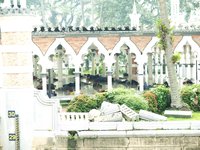Collection:
Date:
Images:
|
Makan
November 2006
10
|
Malaysia is probably the best place in the world for people who
like to eat. You can get everything Asian and Western, most of it is easily
accessible, and it's quite cheap. Malay, Indian and Chinese cuisine are really
good, and in addition you'll find Thai and Japanese food in a lot of places.
Of course, for those who need it, there is also an abundance of burger shops
and other western fast food venues.
But my favourite places are the small local restaurants and food
courts where they only have a small selection of specialties, all of which I've
never seen in an Asian restaurant in Germany, and most of which are pretty
good. I think I'm constantly over-eating when I'm in Malaysia.
Singapore may be similar to KL in terms of food, and even a bit
better stocked in some departments (pork ...), but in Malaysia you can go to a
much better quality restaurant for the same amount of money.
My favourite breakfast is Roti Canai. They are also called Roti
Prata in Singapore, or Murtabak Kosong in Brunei. Murtabak in Malaysia is a
Roti Canai filled with something, and "kosong" in this context means "empty"or
"nothing", so a Murtabak Kosong is actually a Roti Canai filled with nothing.
I.e., the combination of the Murtabak operator and the Kosong operator yield
the identity transformation on Roti Canai. Originally, Roti Canai is an Indian
dish, and in India they are called "Prata" as well. ("Roti" is the Hindi and
Malay word for bread.)
Actually I lived in Malaysia for almost a year before I had Roti
Canai for the first time. Unbelievable. I went for a diving weekend on Tenggol
with my friends, and we arrived friday night in Kuala Besut. The next morning,
Zul, the dive operator, would assemble his troupe and lead us to a little
restaurant near the harbour, where he ordered stacks of Roti Canai and
Malaysian coffee while his boatmen prepared the boat. This was one of the best
breakfasts I ever had, and it's one of the things from Malaysia that I miss
most. Everytime I'm back to Malaysia, the first thing I do on the first morning
is to go to some outdoor Roti shop and have some Roti and a Malaysian
coffee.
I tried to make some Roti Canai at home, but didn't succeed. One
problem may be the consistency of the dough: in my temperate kitchen, it is
considerably harder than in an outdoor stall in the tropics. But I think the
real art is in the whirling technique. The roti man takes a doughball, flattens
it, and then whirls it through the air several times to make a thin sheet. He
greases the sheet with ghee, folds it back inwards, and repeats the procedure
two or three times. The result looks like a pancake and is fried, and like a
puff pastry, it is supposed to ... well ... puff. Rotis are then served with
Indian curry gravy.
You can also buy ready made Roti Prata in Asian shops, but it's
not the same.
|
More food pictures can be found
 here
on the web site of
here
on the web site of
 River
Ko
. He is really a gifted photographer, especially if you consider
that he takes most of his photos with a small point-and-shoot camera.
River
Ko
. He is really a gifted photographer, especially if you consider
that he takes most of his photos with a small point-and-shoot camera.
![]() here
on the web site of
here
on the web site of
![]() River
Ko
. He is really a gifted photographer, especially if you consider
that he takes most of his photos with a small point-and-shoot camera.
River
Ko
. He is really a gifted photographer, especially if you consider
that he takes most of his photos with a small point-and-shoot camera.














